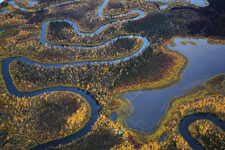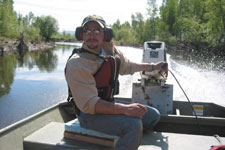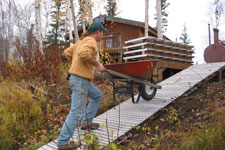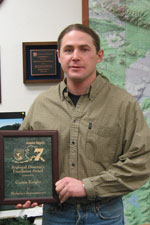Questions spark undergrad research
![]()

The Kanuti River twists and turns past Kanuti Lake (at right) in fall 2005. The green
roof of the Kanuti Wildlife Refuge’s administrative cabin is visible in the lower
middle part of the photograph.
![]()

UAF
student Curtis Knight worked with another technician to collect habitat
data at specific sites on the Kanuti River. They used a measuring stick
to record the height of vegetation.
![]()

Knight collected tree ring samples from black spruce and other trees along the
Kanuti River.
![]()

As part of his research, Knight used a boat to access bird survey data collection
points on the Kanuti River.
![]()

The
problem: water levels on the Kanuti River fluctuate as much as 20 feet during
the season, making the boat launch area muddy and unsafe.
![]()

The solution: Knight designed and built modular pieces
of decking for use during boat launch and docking operations which can easily
be taken apart and moved to a more appropriate location as the water level
rises and falls.
![]()

Knight
built ramps and walkways to help workers navigate the steep embankment between
water and camp. The aluminum grate decking sections are attached to each
other using turnbuckles so they are easy to separate and move around as needed.
By Doreen Fitzgerald, School of Natural Resources and Agricultural Sciences (name change: Institute of Agriculture, Natural Resources and Extension)
April 2006

Knight received the U.S. Fish and Wildlife Service Regional Director’s Excellence Award for Workplace Improvements
How does the quality of qiviut from wild and domestic muskoxen compare? What kind of habitat is related to avian species diversity? How is lettuce affected by the shape and size of the containers transplants are grown in?
The students who set out to answer these disparate questions all had one thing in common: they were enrolled in the Senior Thesis in Natural Resources Management class in the School of Natural Resources and Agricultural Sciences. To graduate, natural resource management majors must complete this two-semester course. During the course of the class each student must identify and define a research question; conduct an experiment, gather survey data or analyze existing literature to answer the question; discuss or defend conclusions and support them with existing literature; and share the results in a public presentation.
Senior Curtis Knight did his research project in Kanuti National Wildlife Refuge while working for the U.S. Fish and Wildlife Service. Knight is investigating the relationship of habitat diversity to avian species richness along a Kanuti River breeding bird survey route first established in 1991.
"We did the surveys in June, when the birds are singing," Knight said. "You get up at 2 in the morning, get in a boat and stop at each of 50 data collection points spaced out along the river. The biologists identify the birds by sight or by song. My project was to come back later with a biologist and a technician to identify the habitat at each of the points."
The 1.6 million-acre refuge is located in interior Alaska approximately 150 miles north of Fairbanks. Knight has worked for the refuge as a biological science technician since 2002 under the agency’s student temporary employment program.
When students do research outside of the laboratory they learn how unpredictable fieldwork can be. For Knight, it was smoke from wildfires and low water in the rivers that complicated his habitat data collection.
"I first went out there during the summer of 2004," Knight said. "That was a bad fire year, there was a lot of smoke and extreme low water conditions. During the time I was there I was able to access only a few data collection points because the water was so low I couldn’t get a boat in to the places we needed to go. The smoke was getting intense and our data collection was compromised so they pulled us out for safety reasons."
Instead, Knight is using Landsat satellite imagery to determine the habitat types present on the river. "I have been able to use the satellite images plus aerial photos, along with the information I collected on the ground, to identify the habitat types at each of the data points," Knight said.
"The process itself is as important to students as the end product," said professor Patricia Holloway, the thesis course coordinator. "This is the first time many students work on an independent research project, and they learn how to work with a committee, three professionals in their research area. The thesis project is an opportunity seldom available to undergraduates. Although it is a lot of work for the faculty, they get to see the students develop in remarkable ways."
During the research and thesis presentations, students demonstrate competency in problem solving, analysis and written and oral communication. Theses are judged on content and how effectively the student presents his or her research results.
"The students gain experience writing in the natural resources field and in presenting their findings, as well as determining what to do and how to do it," Holloway said, noting that students often use the thesis as an example of their written communication skills when applying for jobs. A review of qualifications listed in natural resource management job advertisements quickly reveals that communication skills are important, regardless of the area of specialization.
During the course of his job, Knight was also asked to apply his creative thinking and past experience working construction jobs to solve site condition problems at the Kanuti refuge’s administrative cabin.
"The levels of the lake and the river at the cabin fluctuate about 20 feet or so depending on the season," Knight said. "At high water in the spring and fall the water is near the cabin and then it drops about 20 feet in the middle of the summer. The water was taking out the existing staircase so I designed something that could be deployed as the water goes down and picked up as it comes up."
This winter he received the Regional Director’s Excellence Award for Workplace Improvements for designing and implementing improvements to the boat launch area, walkways and fuel storage facility. The relatively inexpensive improvements made an outstanding contribution to the safety of employees working at the cabin.

U.S. Fish and Wildlife Service Biologist Lisa Saperstein goes over methods for collecting habitat data with UAF student Curtis Knight.
"Kanuti is a great place to gain work experience in the natural resources field," Knight said, "and aside from the opportunity to study and learn in a northern ecosystem, I think the people who staff the refuge are exceptional. Their knowledge, skills and relaxed camp humor have made the work experience even better."
"The refuge is really beautiful," Knight said. "When you stand on the cabin deck and look south you’re looking directly at the Ray Mountains. It really is a spectacular backdrop. It’s a lowland area along the river, there’s a lot of wet muskeg, mossy type of habitat and when you get up in areas that are more dry there are spruce and birch trees. It’s a typical Alaskan boreal forest. The only way to access it is by aircraft in the summertime or by snowmachine in the winter--if you know how to get out there."
At the end of their projects, the students present their completed research in a formal university seminar setting, with an audience that may include faculty, the student’s peers, guest lecturers and scientists, agency personnel, and other members of the university community. It must include visual aids and is followed by a short question and answer period.
"The most amazing thing to watch is how in the beginning, many students are at a loss," Holloway said, "and their proposal presentations are often rough. But by the time they finish and make their final presentations, the students are polished and professional."
"I think the most important thing a student gets from the course is the opportunity to make a specific project their own, of taking ownership of it and responsibility for it," said professor Milan Shipka. "They have to work independently and be professional. It’s an introduction to what many of them will be required to do in the workplace."
Knight plans to graduate in December of 2006. "I will be giving my presentation for this class in the fall. The thesis class kind of establishes the framework for you to move on to do a master’s degree if that’s what you want to do."
For Knight part of the reward of being a natural resources major is the opportunity to spend time in remote Alaska wilderness locations.
"Sometimes bull moose come to feed near Kanuti Lake at sunset. The Ray Mountains turn red from the setting sun, especially in the fall when the colors are coming out. The alpenglow light is really fantastic. It’s amazing how the colors change there throughout the day, depending on the lighting."
Spectacular scenery in a place few ever see may not be part of the course syllabus for every student in the Senior Thesis in Natural Resources Management class, but for Curtis Knight the opportunity to work in the field made the class an even more educational experience.
For more information, please contact:
-
Doreen Fitzgerald, information officer, School of Natural Resources & Agricultural Sciences/Agricultural & Forestry Experiment Station, University of Alaska Fairbanks, (907) 474-5042, fndlf2@uaf.edu
-
Patricia Holloway, professor of horticulture, School of Natural Resources and Agricultural Sciences, University of Alaska Fairbanks, (907) 474-5651, ffpsh@uaf.edu
Other useful links:
- School of Natural Resources and Agricultural Sciences (name change: Institute of Agriculture, Natural Resources and Extension)
- Kanuti National Wildlife Refuge
- SNRAS Senior Thesis Web Publications
Photos courtesy U.S. Fish and Wildlife Service.
Browse UAF feature story archives


